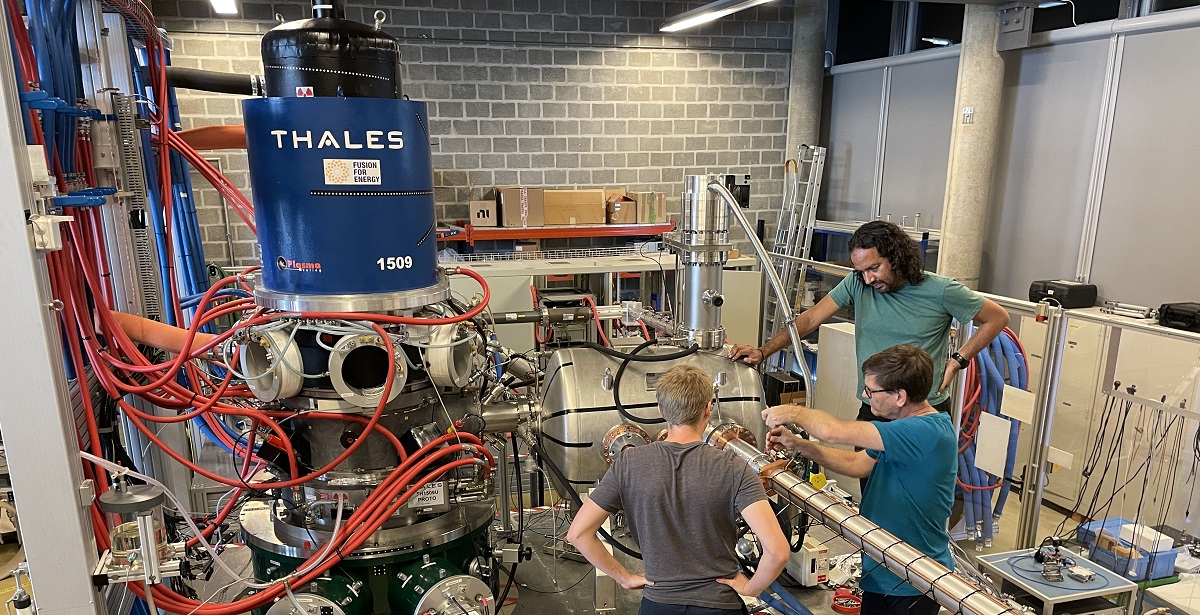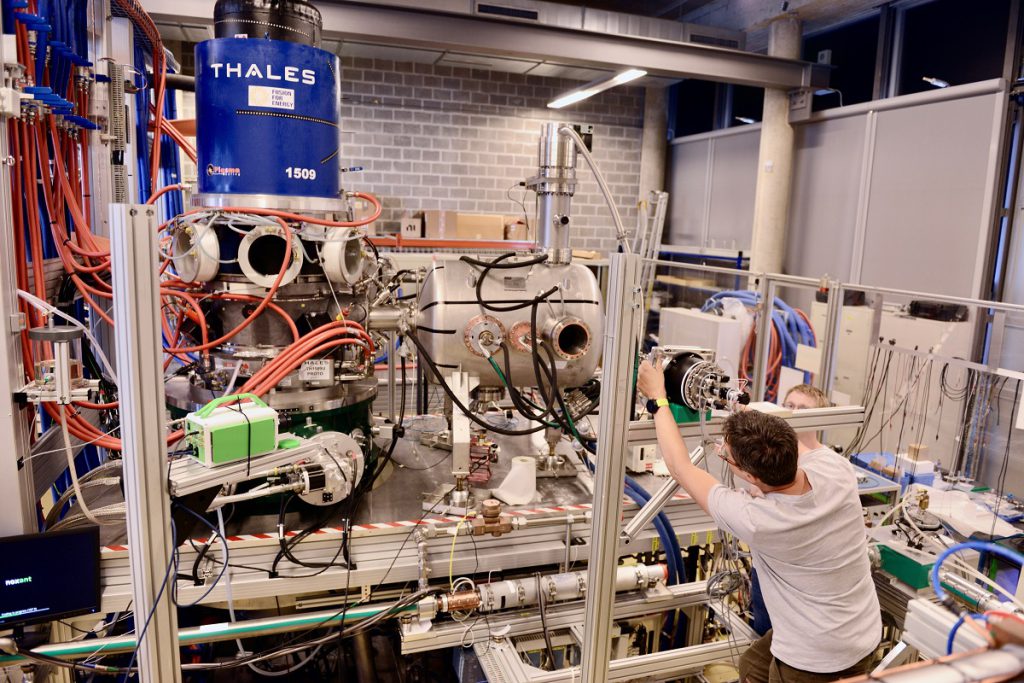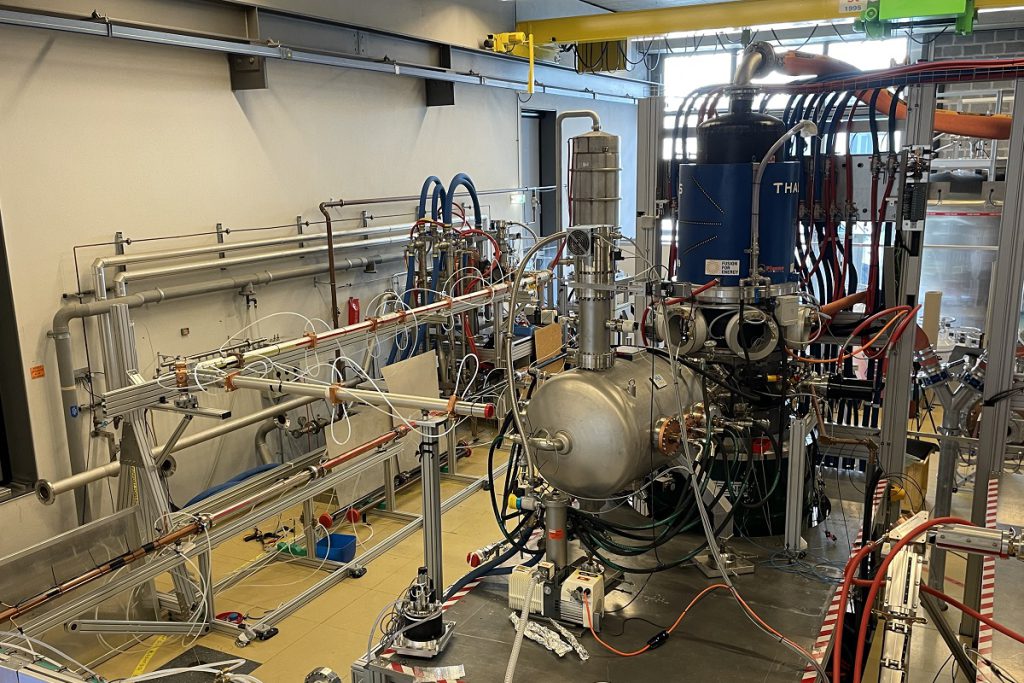F4E and Thales to unleash high-energy microwaves in ITER plasma

Operators checking the alignment of equipment connected to the European gyrotron prototype at the Falcon test facility in the Swiss Plasma Center, EPFL, Switzerland, July 2022. © EPFL
Several ITER systems will heat the plasma to reach the 150 million °C for fusion reactions to occur. The ITER Electron Cyclotron system will use radiofrequency (RF) waves – very high energy microwaves. They will be produced in devices called gyrotrons, and will travel through waveguides – transmission lines – till they reach the launchers that will inject them in the plasma.
F4E has signed a contract with Thales for the manufacturing of six gyrotrons. Each of them consists of a 3-metre-tall vacuum tube in which electrons gyrate – hence the name of the device. An electron gun “fires” these particles, which move helically in a magnetic field produced by a surrounding superconducting magnet. The laws of physics explain that electrical charges submitted to these conditions emit electromagnetic radiation – RF waves in this case. A system of mirrors in the gyrotron will guide the RF waves beam out of the device so that they can follow their way to the vacuum vessel. Each gyrotron will produce RF waves of 1 MW of power at 170 GHz – the optimal frequency to heat the electrons of the plasma. Apart from the European contribution, Russia, Japan and India will also deliver gyrotrons to ITER Organization. In total, 24 gyrotrons will be used to bring 20 MW of power to the heart of the machine.

F4E decided to join forces with the Italian Divertor Tokamak Test Project (DTT) to prepare the tender of this contract. DTT is a superconducting tokamak aimed at testing various divertor concepts under plasma conditions that can be extrapolated to DEMO, the fusion machine that will follow ITER. Having a joint tender optimises the manufacturer’s resources, resulting in a more competitive price for both parties. The joint F4E-DTT tender procedure requested in total 22 gyrotrons – 6 for F4E and 16 for DTT.
Gustavo Granucci, DTT Senior Researcher, shares his thoughts. “The common effort to set up the gyrotron tender has been of great help for us, starting from an already solid ground. F4E colleagues shared their experience and demonstrated great flexibility and availability to adapt the procedure and the technical documentation. In the end, this joint work has given us the opportunity to establish a base to continue the collaboration in the field of Electron Cyclotron Heating, of common interest to DTT and F4E, and a synergy of great value for a starting project like DTT.”

The activities of the contract between F4E and Thales will have a cost of 20 million EUR and will run for a period of 68 months. Thales will have to fabricate six gyrotrons with a reliability of 98 %, in other words, the device will produce at least 98 out of 100 microwave pulses keeping the right frequency. Also, 50% electrical efficiency is expected, so they will produce 1 MW of microwave power from 2 MW of electrical power.
“Thales is proud to be part of the team working on the ITER Electron Cyclotron by manufacturing state-of-the-art gyrotrons. This is the result of a long term, successful collaboration between industry and leading European labs and institutions. The upcoming milestones include the full preparation for series production of this very demanding solution, from supply chain to full testing, and the on-time delivery of target performances over the next decade,” explains Antoine Loidreau, Defence, Science, Industry and Telecom business segment Director at Thales Microwave & Imaging Sub-Systems.
Paco Sánchez, F4E Project Manager following this contract, gives us more details. “The last modifications performed by Thales in the European prototype are aimed at complying with the challenging requirements described above. In order to better consolidate a successful technical design, the common strategy agreed between F4E and DTT is to first produce and test a DTT pre-series gyrotron, which will allow checking those performance levels and then move forward with the manufacturing of the F4E and DTT series units. An excellent collaboration F4E-DTT will help ensure the achievement of those objectives both for the DTT and ITER projects.”